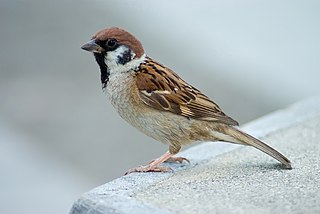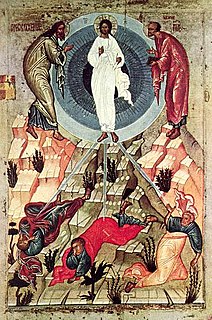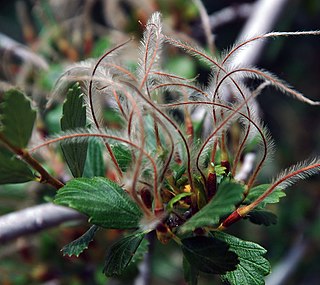Montanism, known by its adherents as the New Prophecy, was an early Christian movement of the late 2nd century, later referred to by the name of its founder, Montanus. Montanism held views about the basic tenets of Christian theology similar to those of the wider Christian Church, but it was labelled a heresy for its belief in new prophetic revelations. The prophetic movement called for a reliance on the spontaneity of the Holy Spirit and a more conservative personal ethic. Parallels have been drawn between Montanism and modern-day movements such as Pentecostalism and the Charismatic movement.

The Eurasian tree sparrow is a passerine bird in the sparrow family with a rich chestnut crown and nape, and a black patch on each pure white cheek. The sexes are similarly plumaged, and young birds are a duller version of the adult. This sparrow breeds over most of temperate Eurasia and Southeast Asia, where it is known as the tree sparrow, and it has been introduced elsewhere including the United States, where it is known as the Eurasian tree sparrow or German sparrow to differentiate it from the native unrelated American tree sparrow. Although several subspecies are recognised, the appearance of this bird varies little across its extensive range.

Christian mysticism in ancient Africa took form in the desert, as part of a long-reaching Judeo-Christian mystical tradition. In the Judeo-Christian mystical tradition, the desert is known to induce religious experiences and altered states of consciousness.
The mountain noctule is a species of bat found in Afghanistan, India, Pakistan, and Nepal.

The small big-eared brown bat is a species of vesper bat in the family Vespertilionidae. It can be found in the following countries: Argentina, Bolivia, Brazil, Chile, Colombia, Ecuador, Peru, Uruguay, and Venezuela.

The montane vole is a species of vole native to the western United States and Canada.
The Nillu rat or Sri Lankan mountain rat is a species of rodent in the family Muridae. It is found only in Sri Lanka where it is known as நில்ளு எலி in Tamil and නෙලූ මීයා(Nelu Meeya) in Sinhalese.
The plains harvest mouse is a species of rodent in the family Cricetidae. It is found in northern Mexico and the central United States.

The montane racket-tail or the Luzon racket-tail, is a species of parrot in the family Psittaculidae. It is endemic to northern Luzon in the Philippines.

The Asian highland shrew is a species of mammal in the family Soricidae. It is found in India and Sri Lanka. Its habitat is subtropical or tropical dry forests. It is threatened by habitat loss. It is known as ශ්රී ලංකා කදු හික් මීයා in Sinhala.
Montanus is a Latin word meaning mountain.
The Sumatran Muntjac is a subspecies of Indian muntjac in the deer family which can be the size of a large dog. It was discovered in 1914, but had not been sighted since 1930 until one was snared and freed from a hunter's snare in Kerinci Seblat National Park, Sumatra, Indonesia in 2002. Two other Sumatran muntjac have since been photographed in the park. The Sumatran Muntjac was placed on the IUCN Red List in 2008, but was listed as Data Deficient, as taxonomical issues are still unresolved. The distribution of the species is also uncertain and may be more extensive than suggested. It is possible that some previous sightings of the common muntjac in Western Sumatra were the Sumatran muntjac.

Cercocarpus montanus is a North American species of shrub or small tree in the family Rosaceae native to northern Mexico and the western United States. It is known by the common names alder-leaf mountain-mahogany, alder-leaf cercocarpus, and true mountain-mahogany. The variety argenteus is commonly known as silverleaf mountain-mahogany.
Monosyntaxis persimilis is a moth of the family Erebidae. It was described by Walter Rothschild in 1912. It is found in New Guinea, where it is distributed in mountainous areas in the central part of the island, up to the Wandammen Mountains in the west. It is also found in Papua New Guinea.
Monosyntaxis affinis is a moth of the family Erebidae. It was described by Walter Rothschild in 1912. It is found on Peninsular Malaysia and Java.
Monosyntaxis ochrosphena is a moth of the family Erebidae. It was described by Wileman and West in 1928. It is found on Luzon in the Philippines.
Monosyntaxis radiifera is a moth of the family Erebidae. It was described by Karel Černý in 1995. It is found on Mindanao in the Philippines.
Monosyntaxis samoensis is a moth of the family Erebidae. It was described by Hans Rebel in 1915. It is found on Samoa in the South Pacific Ocean.
Monosyntaxis trimaculata is a moth of the family Erebidae. It was described by George Hampson in 1900. It is found on Borneo. The habitat consists of upper montane forests.
The Lithosiina are a subtribe of lichen moths in the family Erebidae. The taxon was erected by Gustaf Johan Billberg in 1820.






